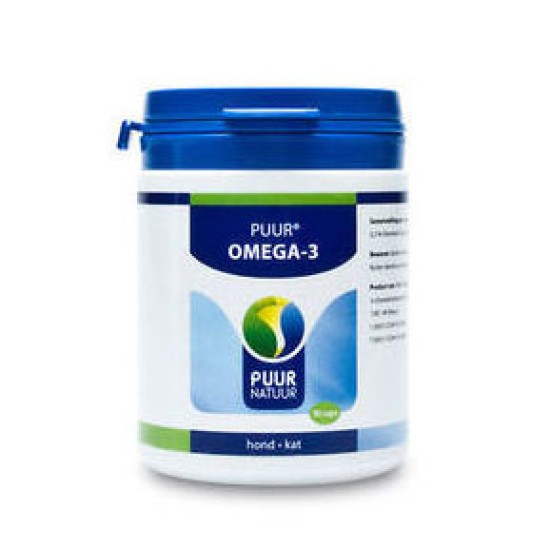PUUR Omega-3 capsules
PUUR Omega-3 capsules
€ 25.95
Ex Tax: € 21.45
Your shopping cart is empty!

For smooth movement. For healthy skin and coat. For the heart. For hypersensitivities. For healthy intestines. For the immune system. For mental health.
Suitable for: Human, Cat, Dog, Rodent, Horse, Pony, Bird
Composition : (per capsule) fish oil 1000 mg of which EPA 180 mg and DHA 120 mg. 0.3% Vitamin E (d-alpha-tocopherol).
Indication(s): For supple joints and for a good coat condition. For heavy shedding or red skin. As a standard supplement to the diet for maintaining a healthy skin and coat condition.
Properties per ingredient: Polyunsaturated fatty acids can be divided into two large families: the omega-3 family (alpha-linolenic acid group) and the omega-6 family (linoleic acid group). Because the animal body cannot produce these fatty acids itself, omega-3 and omega-6 fatty acids must be ingested through food or supplementation. These essential fatty acids used to be called vitamin F. In the twentieth century, the ratio of omega-3 to omega-6 fatty acids in food has shifted strongly towards omega-6 fatty acids. The increasing use of vegetable oils and fats, which are rich in omega-6 fatty acids, stimulates the formation of arachidonic acid, at the expense of EPA and DHA. Arachidonic acid itself is abundant in the Western diet. It is estimated that the ratio of omega-6 to omega-3 fatty acids in the Western diet is approximately 20-25: 1. Researchers state that a ratio of approximately 5: 1 is more desirable. Evolutionarily, the dog (and its predecessors) has consumed omega-6 and omega-3 in a ratio of (probably) 1:1 for millions of years. The enzyme delta-6-desaturase regulates both the conversion of linoleic acid to DGLA and the conversion of ALA to (ultimately) EPA. With an excess of linoleic acid, this results in ALA hardly being able to use the enzyme, and therefore hardly any EPA and DHA are formed. This enzyme is already the slowest step in the chain and the functioning of this enzyme is also inhibited by many factors in the diet (including trans fatty acids, saturated fats, zinc, magnesium and/or vitamin B6 deficiencies, alcohol) and metabolic factors (hypercholesterolemia, diabetes, certain medications). This results in the fact that in our Western society many animals can hardly form GLA and EPA themselves, and that these fatty acids must therefore be supplied via the diet.
Dosage and application: Unless otherwise prescribed by the physician or therapist. Optimal dosage 1 x daily: (Build up dosage slowly).
Dog 1 - 3 capsule(s)
Cat 1 - 2 capsule(s) Administration directly into the mouth or through the food.
Advice for use In an acute situation, the dosage may be increased on the advice of a veterinarian. When administering Omega-3 oil, loose stools may occur at first. Build up slowly if necessary.
Duration of treatment Omega-3 fatty acids are incorporated into the cell membranes. This is a process of several days to 2 weeks. The effect is usually visible after 1 to 3 weeks. After the symptoms have decreased, a maintenance dose can be used. This is usually half of the dosage indicated on the packaging. When dosing this product, carefully observe the animal's reaction. A higher dosage may be necessary at the beginning, this product can safely be given in double dosage. Gradually reduce the dosage when the symptoms have decreased or disappeared to the lowest possible dosage. This product can be given permanently for chronic symptoms. Storage Store in the refrigerator after opening. The effectiveness of the polyunsaturated fatty acids may decrease under the influence of light and oxygen. Keep out of reach of children. Synergy and combinations with other products This product can be used without any problems in combination with other natural health products and regular medicines.
Contraindications There are no known contraindications at the indicated dosage.
Side effects When using high doses of fish oil (more than 5 grams of EPA + DHA per day) there is a risk of loose stools.
Interactions Because omega-3 fatty acids have the property of inhibiting blood clotting, animals that use blood thinners, have a vitamin K deficiency or use other medications that inhibit blood clotting (aspirin) may experience internal bleeding when using high doses of omega-3 fatty acids (more than 5 grams of EPA + DHA). In such cases, it is recommended to adjust the dosage. The effect on blood clotting by omega-3 fatty acids is maximal after 6 weeks of treatment.
| Variant | |
| Contents | 90 caps |
